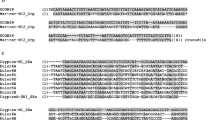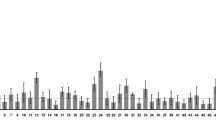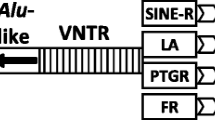Abstract
We report eleven new families of MEdium Reiteration frequency (MER) interspersed repeats in the genomes of Primates, Rodentia, and Lagomorpha. Two families of the human repeats, MER46 and MER47, represent non-autonomous DNA transposons. These sequences are flanked by TA target site duplications and have terminal inverted repeats (TIRs) similar to TIRs of DNA transposons. The sequences of five other families of repeats, MER41, MER48, MER50, MER51, and RMER3, resemble long terminal repeats of retroviruses. A potential involvement of some of the reported MER repeats in the regulation of transcription and genetic rearrangements is suggested. Age estimations place the origin of most MER repeats at the time of decline in MIR (Mammalian-wide Interspersed Repeats) retroposition and before the origin of the Alu family.
Similar content being viewed by others
References
Altshul, S.F., W. Gish, W. Miller, E.W. Myers & D.J. Lipman, 1990. Basic local alignment search tool. J. Mol. Biol. 215: 403–410.
Arnold, G.J., B. Kahnt, K. Herrenknecht & H.J. Gross, 1987. A variant gene and a pseudogene for human 5S RNA are transcriptionally active in vitro. Gene 60: 137–144.
Auffray, C., J.W. Lillie, A.J. Korman, J.M. Boss, N. Frechin, F. Guillemot, J. Cooper, R.C. Mulligan & J.L. Strominger, 1987. Structure and expression of HLA-DQ alpha and-DX alpha genes: interallelic alternate splicing of the HLA-DQ alpha gene and functional splicing of the HLA-DQ alpha gene using a retroviral vector. Immunogenetics 26: 63–73.
Batzer, M.A., M. Stoneking, M. Alegria Hartman, H. Bazan, D.H. Kass, T.H. Shaikh, G.E. Novick, P.A. Ioannou, W.D. Scheer & R.J. Herrera, 1994. African origin of human-specific polymorphic Alu insertions. Proc. Natl. Acad. Sci. U.S.A. 91: 12288–12292.
Berg, D.E. & M.M. Howe (eds.), 1989. Mobile DNA, edited by American Society for Microbiology, Washington, DC.
Bird, A.R., 1980. DNA methylation and the frequency of CpG in animal DNA. Nucleic Acids Res 8: 1499–1504.
Britten, R.J., 1994. Evidence that most human Alu sequences were inserted in a process that ceased about 30 million years ago. Proc. Natl. Acad. Sci. USA 91: 6148–6150.
Colloms, S.D., H.G.A.M.van Luenen & R.H.A. Plasterk, 1994. DNA binding activities of the Caenorhabditis elegans Tc3 transposase. Nucl. Acids Res. 22: 5548–5554.
Deininger, P.L. & G.R. Daniels. The recent evolution of mammalian repetitive DNA elements. Trends Genet. 2: 76–80.
Faulkner, D.V. & J. Jurka, 1988. Multiple aligned sequence editor (MASE). Trends Biochem. Sci. 13: 321–322.
Fitch, D.H.A., W. Bailey, D.A. Tagle, M. Goodman, L. Sieu & J.L. Slightom, 1991. Duplication of the globin gene mediated by L1 long intrespersed repetitive elements in an carly ancestor of simian primates. Proc. Natl. Acad. Sci. USA 88: 7396–7400.
Goodman, M., D.A. Tagle, D.H.A. Fitch, W. Bailey, J. Czelusniak, B.F. Koop, P. Benson & J.L. Slightom, 1990. Primate evolution at the DNA level and a classification of Hominoids. J. Mol. Evol. 30: 260–266.
Hake, L.E. & N.B. Hecht, 1993. Utilization of an alternative transcription initiation site of somatic cytochrome c in the mouse produces a testis-specific cytochrome c mRNA. J. Biol. Chem. 268: 4788–4797.
Jurka, J. & A.F.A. Smit, 1995. A reference collection of human repeats. In Repbase, NCBI Data Repository.
Jurka, J., 1990. Novel families of interspersed repetitive elements from the human genome. Nucleic Acids Res. 18: 137–141.
Jurka, J., 1994. Approaches to identification and analysis of interspersed repetitive DNA sequences, pp. 294–298 in Automated DNA sequencing and analysis, edited by M.D. Adams, C. Fields and J.C. Venter. Academic Press Inc., San Diego, CA.
Jurka, J., D.J. Kaplan, C.H. Duncan, J. Walichiewicz, A. Milosavljevie, G. Murali & J.F. Solus, 1993. Identification and characterization of new human medium reiteration frequency repeats. Nucleic Acids Res. 21: 1273–1279.
Jurka, J., E. Zietkiewiez & D. Labuda, 1995. Ubiquitous mammalian-wide interspersed repeats (MIRs) are molecular fossils from the mesozoic era. Nucleic Acids Res. 23: 170–175.
Jurka, J., P. Walichiewicz & A. Milosavljevic, 1992. Prototypic sequences for human repetitive DNA. J. Mol. Evol. 35: 286–291.
Jurka, J., P. Klonowski, V. Dagman & P. Pelton, 1996. CENSOR—A program for identification and elimination of repetitive elements from DNA sequences. Computers Chem. 20: 119–121.
Kapitonov, V. & J. Jurka, 1996. The age of Alu subfamilies. J. Mol. Evol. 42: 59–65.
Kaplan, D.J., J. Jurka, J.F. Solus & C.H. Duncan, 1991. Medium reiteration frequency repetitive sequences in the human genome. Nucleic Acids Res. 19: 4731–4738.
Kawakami, K., H. Okamoto, Y. Yagawa & K. Nagano, 1990. Regulation of Na+,K(+)-ATPase. II. Cloning and analysis of the 5′-flanking region of the rat NKAB2 gene encoding the beta 2 subunit. Gene 91: 271–274.
Labuda, D. & G. Striker, 1989. Sequence conservation in Alu evolution. Nucl. Acids. Res. 17: 2477–2491.
Lania, L., A.Di Cristofano, M. Strazzulio, G. Pengue, B. Majello & G.La Mantia, 1992. Structural and functional organization of the human endogenous retroviral ERV9 sequences. Virology 191: 464–468.
Lee, R.N., J.C. Jaskula, R.A.van den Bussche, R.J. Baker & H.A. Wichman, 1996. Retrotransposon Mys was active during evolution of the Peromyscus leucopus-maniculatus complex. J. Mol. Evol. 42: 44–51.
Mager, D.L. & J.D. Freeman, 1987. Human endogenous retrovirus-like genome with type C pol sequences and gag sequences related to human T-cell lymphotrople viruses. J. Virology 61: 4060–4066.
Maraia, R. (ed.), 1995. Molecular Biology Intelligence Unit: The Impact of Short Interspersed Elements (SINEs) on the Host Genome, edited by R.G. Landes Company, Texas.
Morgan, G.T., 1995. Identification in the human genome of mobile elements spread by DNA-mediated transposition. J. Mol. Biol. 254: 1–5.
Onda, M., S. Kudo, A. Rearden, M.-G. Mattei & M. Fukuda, 1993. Identification of a precursor genomic segment that provided a sequence unique to gylcophorin B and E genes. Proc. Natl. Acad. Sci. USA 90: 7220–7224.
Oosumi, T., W.R. Belknap & B. Garlick, 1995. Mariner transpo sons in humans. Nature 378: 672.
Robertson, H.M., 1993. The mariner transposable element is widespread in insects. Nature 362: 241–245.
Smit, A.F.A. & A.D. Riggs, 1995. MIRs are classic, tRNA-derived SINEs that amplified before the mammalian radiation. Nucleic Acids Res. 23: 98–102.
Smit, A.F.A. & D.A. Riggs, 1996. Tiggers and other DNA transposon fossils in the human genome. Proc. Natl. Acad. Sci. USA 93: 1443–1448.
Smit, A.F.A., 1993. Identification of a new, abundant superfamily of mammalian LTR-transposons. Nucleic Acids Res. 21: 1863–1872.
Smit, A.F.A., G. Toth, A.D. Riggs & J. Jurka, 1995. Aneestral, mammalian-wide subfamililes of LINE-1 repetitive sequences. J. Mol. Biol. 246: 401–417.
Takasaki, N., S. Murata, M. Saitoh, T. Kobayashi, L. Park & N. Okada, 1994. Species-specific amplification of tRNA-derived short interspersed repetitive elements (SINEs) by retroposition: a process of parasitization of entire genomes during the evolution of salmonids. Proc. Natl. Acad. Sci. USA 91: 10153–10157.
Usdin, K., P. Chevret, F.M. Catzeflis, R. Verona & A.V. Furano, 1995. L1 (LINE-1) retrotransposable elements provide a “fossil” record of the phylogenetic history of murid rodents. Mol. Biol. Evol. 12: 73–82.
Varmus, H.E., 1982. Form and function of retroviral proviruses. Science 216: 812–820.
Vos, J.C. & R.H.A. Plasterk, 1994. Tel transposase of Caenorhabditis elegans is an endonuclease with a bipartite DNA binding domain. EMBO J. 13: 6125–6132.
Wilson, A.C., V.M. Sarich & L.R. Maxson, 1974. The importance of gene rearrangement in evolution: evidence from studies on rates of chromosomal, protein, and anatomical evolution. Proc. Natl. Acad. Sci. USA 71: 3028–3030.
Author information
Authors and Affiliations
Rights and permissions
About this article
Cite this article
Jurka, J., Kapitonov, V.V., Klonowski, P. et al. Identification of new medium reiteration frequency repeats in the genomes of Primates, Rodentia and Lagomorpha . Genetica 98, 235–247 (1996). https://doi.org/10.1007/BF00057588
Received:
Accepted:
Issue Date:
DOI: https://doi.org/10.1007/BF00057588




